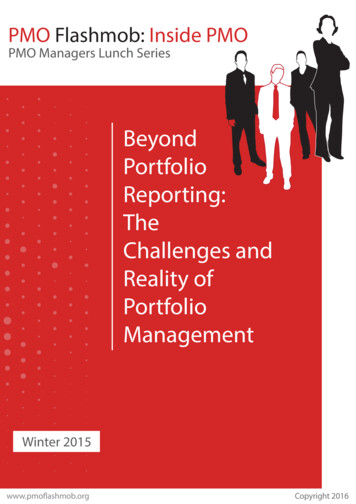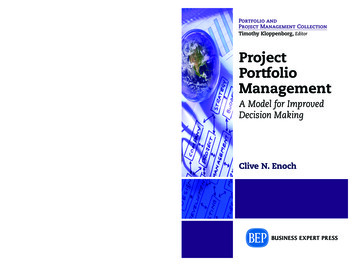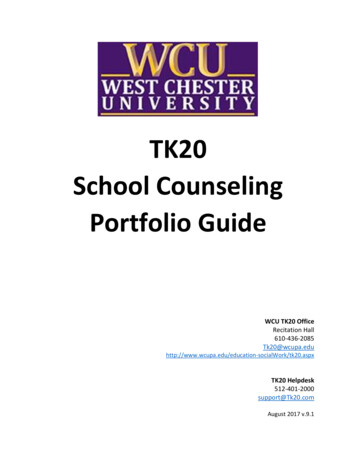
Transcription
PMO Flashmob: Inside PMOPMO Managers Lunch SeriesBeyondPortfolioReporting:TheChallenges andReality ofPortfolioManagementWinter 2015www.pmoflashmob.orgCopyright 2016
The Overview1. Portfolio Management is still not understood well enough within organisations2. The PMO has to become more business focused - more dynamic, strategic and analytical3. Theoretical portfolio management guidance accounts for only 30% of what is implemented4. “Doing the right projects and doing the projects right”, the basics of programme and projects still need attention5. The PMO need skills in relationship management and data analysis - a true combination of hard and soft skills6. The PMO is both an enabler and a disruptor7. Portfolio PMO needs a paradigm shift
“PMO Managers have to workthrough the “even though wedidn’t ask for this, now we’vegot it, we now understandthat’s what we want.” withtheir senior executives.”PMO Flashmob: Inside PMOEarly December in London’s Fleet Street and PMO Flashmob - the PMO networking group - hosted the first‘PMO Managers’ Lunch’. These events bring together PMO Managers, from a number of different industries, to talk in-depth about a particular PMO topic. At this lunch, the subject was “Beyond PortfolioReporting - The Challenges and Reality of Portfolio Management”.As organisations look to improve on the returnsfrom strategy development and increase maturityin programme and project management deliverycapability, portfolio management has increasinglytaken centre stage as a business function to support that. Portfolio management is seen as the‘glue’ or ‘bridge’ between strategy and strategyexecution (delivered by programmes and projects).The PMO or Portfolio Office is the place whereportfolio management practices become a realityfor an organisation.The biannual PMO Managers Lunch is a PMOFlashmob Plus event. With PMO Flashmob thereare great conversations amongst different typesof PMO people and this event gives us anopportunity to bring together leaders of PMOs PMO Managers to discuss PMO topicsthat are relevant today.It is an opportunity for PMO Managers to talk toother PMO Managers in different industries. Wealso wanted the opportunity to understand whatis happening in PMOs today – PMOs in thereal world.We were also conscious that there is not a lot ofPMO benchmarking available either formally orinformally and this is an informal benchmarkingopportunity which brings insights that othersfrom within the PMO community can share andlearn from.This article provides those insights from the firstPMO Managers Lunch held on 3rd December2015 in London’s Fleet Street.www.pmoflashmob.orgCopyright 2016
Beyond Portfolio Reporting - The Challenges and Reality of Portfolio ManagementPMO Managers:John McIntyre - TicketmasterChris Walters – VodafoneBrett Dalby - Met PoliceRachel Cook - Lloyd's of LondonJane Cosgrove - DHLLisa Chellar – EquinixStuart Collins – BBCHarri Sharples – DeloitteAnke Bysouth – CAFODSimon Harwood – IFDSJulie Black – OfgemKen Burrell – Financial ServicesHosts: Lindsay Scott & Eileen RodenOver three hours, PMO Managers discussed the realities of portfolio management in their respective organisations, beginning with how portfolio management started within their organisations.The Management of Portfolios was published in 2011-2012 which started a lot of people talking about portfolio management. We were interested to know where the drivers have come from inside your organisation – was it from the business orwas it from good project management professionals, in the widest sense of that term – for example people armed with bestpractice sitting within the PMO? Are we driving portfolio management on behalf of the business or is the business driving it assomething they want and need?For some it was a top down decision. With problems in performanceand senior executives unable to see what delivery commitments arebeing made, a structured portfolio management view provides someheadway to making change visible across the organisation.Another example highlighted portfolio management driven by theorganisation structure with several portfolios existing within thebusiness. An overall enterprise level portfolio office, which ismanaged by the governing body, looks at the twenty most strategicinitiatives. Business units within the organisation also then havetheir own portfolio offices. Due to the size of the organisation, onebusiness unit has six portfolio offices, which reflects the differenttypes of work they are doing i.e., business transformation, newproducts, regulatory, client led projects etc.For others, portfolio management was driven bottom up. Recurringproblems within the programmes and projects drove the PMO toinvestigate and start to understand and address the root causes offailures.“It was the middle managementlevel with demands fromexecutives above on how thingswere going to happen and pullinginformation from the peoplebelow on what’s actually happening. The middle managementlayer has said we need to comeup with a model which managesupwards and manages downwards and it’s grown from there”The group had examples of initial portfolio management implementation stemming from the side too; the PMO and middle management layer. One example highlighted that the senior management executive were quite immature when it came to understanding whatthey needed from a portfolio management office. One approach, by the PMO Manager, was not to wait until senior managementunderstood it – but rather push on and show it to them so they could understand more about what they wanted.Another PMO Manager’s experiences, in an early Enterprise PMO (pre- Management of Portfolios), was that “the implementation was atop down push because the executives wanted a better view of the change that was happening but after a while it was driven from theside i.e., we could show them what else could be done. In terms of portfolio management, even though it wasn’t called that, weconcentrated on portfolio reporting. It was simply checking with the executives that ‘this is how we’re spending the corporate’s money,is this what you want?’ Sometimes the answer was yes and sometimes the answer was no. This was driven from the side, from the PMO,showing the executives what could be done in terms of MI (Management Information) reporting.”For PMO Managers tasked with implementing portfolio management within organisations it serves as a reminder that, “as PMO peoplewe often wait for permission and it very rarely comes in this format (CEO backing)”.www.pmoflashmob.orgCopyright 2016
Beyond Portfolio Reporting - The Challenges and Reality of Portfolio ManagementLack of Understanding aroundPortfolio ManagementThe bottom up and sideways drive of portfolio management is partially in response to the lack of understandingabout what portfolio management actually is and what it can achieve for senior executives and theirorganisations.The majority of PMO Managers stated that their organisations didn’t specifically ask for ‘portfolio management’ insteadarticulating ideal outcomes:“They knew what their strategy was and then approached PPM practitioners to articulate that they wanted projects and programmes ofwork that would meet these strategies. They knew what they wanted to enable the strategy to be realised. In terms of the processes inorder to do this, the senior executives left it to the PMO to work out how that should be done.”“There seems to be an immaturity about what people understand by portfolio management which means it is doomed to failure – acontentious point – but portfolio management is great on paper but in practice it is very rarely done and when it is done, it doesn’tshow value. There’s a real challenge there.”“PMO Managers have towork through the ‘eventhough we didn’t ask forthis, now we’ve got it, wenow understand that’s whatwe want’ with their seniorexecutives.Another example highlighted the problem of perception around programmesand portfolio. “Is it a programme or should it actually be run as a portfolio?One inherited PMO was supporting a programme but actually the investmentof vast millions and strategic importance meant it should have been run as aportfolio. The interesting situation comes when discussions are needed withthe people who are running programmes and talking about bringing inportfolio management practices. The initial reaction is that it is welcomedbecause there is an ego boost there; portfolio is one higher in the hierarchythan programmes.”With portfolio management, there is a danger of saying that you need to ‘sell’the idea and get people on board with it yet there are PMOs that have peoplewho are trying to describe too much at once and it’s overwhelming. The ideaof portfolio management is actually very simple - selecting the rightprogrammes and projects to achieve the strategies.“Yet there is an idea that you would sell the portfolio PMO vision in order to get total buy in which is misinterpreted by people to meanshow me the whole process and examples of portfolio reports which doesn’t really mean anything at the initial stage of implementingportfolio management and that’s a worrying approach.”“Sometimes using the word “portfolio management” is also not right because the PMO is not doing the theoretical stuff but the PMOknows the value they are trying to give to the organisation which is not necessarily being recognised.”In summary, perhaps definitions and what is meantby portfolio, programmes and projects is pretty keyyet they are not very well understood.In another example the PMO Manager had to workwith the seemingly impossible:“PMO Managers have to work through the ‘eventhough we didn’t ask for this, now we’ve got it, wenow understand that’s what we want’ with theirsenior executives.”One thing is clear, in order to obtain the seniorexecutives backing and support for portfoliomanagement; the PMO has to hold conversations,provide information and be able to answerquestions from a strategic business perspective.www.pmoflashmob.orgCopyright 2016
Beyond Portfolio Reporting - The Challenges and Reality of Portfolio ManagementTalking the Language of the BusinessSuccessful PMOs leave the theoretical language of Management of Portfolios (MoP ) and Portfolio, Programme andProject Office (P3O ) to one side.They concentrate on providing information that enables answersto questions from senior executives like, “how can I improve mybottom line?”, “how can I make my customers happier?” and“how can I prioritise the right things for our business that takes usforward with the strategy that I’ve just told you about?”The role the PMO plays in portfolio management brings them closer to business areas such as finance, strategy planning and legal whilststill focusing on programmes, projects and change. A wider remit naturally means a focus on developing wider business skills. PMOManagers here believe development in business areas, even pursuing a MBA, would stand them in better stead for the challenges aheadin managing portfolio PMOs.“Thinking about other departments the Portfolio PMO should have a particularcloseness to - the finance department - the question was asked, “How many ofus are actually close to them?” Two examples bring different insights:The PMO is custodian ofreasonable practice, tryingto influence the decisionmakers and the doers toalign in a particular way.“I found that it’s very difficult to start conversations about projects starting orbeing canned - with the finance department because we are very comfortablewith uncertainty but the finance department don’t like certainty at all.”Another response, “I’ve found that it’s the opposite way around, I’m expectingfinance to know and they’re saying ‘we’re looking at a multi-million poundbusiness and we’re not looking at four projects thinking do we start them ornot start them’. I have to break down their ramblings into ‘are we going do thisor not.”So as we implement portfolio management do we have to develop more relationships with the business side rather than justthe delivery teams from a PMO perspective?One PMO Manager first talked about the type of relationships the Portfolio PMO should be cultivating with both sides, “The portfoliooffice gives a voice to the business, a conduit. Having been a Project Manager before, I know what it’s like trying to get decisions from myproject board and being able to wander past the portfolio office and say ‘could you lot help me out’. If we can build those kind of relationships it will help the business.”In thinking about the Portfolio PMO and relationships further up the hierachy - having the CEO conversation about portfolio management- one view is that it should be ‘give me a view how well and how quickly I can implement the strategy’. No more, no less. But is it all aboutspeed?“There are restraining factors so there is a great big list of things you can do which will satisfy the strategy. You can’t do them all so youhave to time phase them. That answers the question on how quickly I can get to the strategic outcome and can I get to it completely, andif not, is it the right strategy? That’s what the CEO needs to ask – will I ever get there before the business changes to totally invalidate thestrategy?”The Portfolio PMO has the opportunity to take the conversations from the already familiar ground of programme and project delivery tostrategy planning and beyond. One specific example shows how one PMO gets involved at this higher level:“The PMO initially was about project control until the business was trying to work out what they were going to spend in the coming yearand the PMO were asked to look at it. The initial deliverable was an Executive Summary that stated with 100% confidence that ‘you’renot going to be able to deliver everything that was on the wish list’. This led to a state where the PMO tried to find the answers on ‘howdo we fix this?’ At that point the PMO started looking at portfolio management. Initially there was some education needed, and thenlooking at how it could be implemented within the organisation. The PMO today runs the Strategic Planning process as a project with aProject Manager at the beginning of the year, working with all the executives. They carry out compatible analysis, SWOT analysis, workingout what they want to do, then working out through the capacity models and crunching it, trying to tease together the projects theyreally want to do.”www.pmoflashmob.orgCopyright 2016
Beyond Portfolio Reporting - The Challenges and Reality of Portfolio ManagementTheoretical Portfolio Managementas a GuideIf portfolio management is still little understood in its current form and PMO Managers are attempting to enableportfolio management and provide the ‘glue’ from the side, how are they doing this?Each PMO Manager agreed that the current thinking and best management practice is there just as a guide. It is the combination of theory (about 30%) and experience, driven by business needs, that allows them to start implementing portfoliomanagement. One PMO Manager put it down to ‘skill, risk and innovation’, after all; there is no practical manual on how toset up portfolio management, PMO Managers carrying out this role today are at the forefront, creating their own metaphorical manuals.In most cases, the initial, real job of the PMO Manager is not to dive in with a vision, portfolio processes and templates but rather athree step programme of work that can take up to 18 months. It is a commitment that shouldn’t be undertaken lightly.The first step is gaining an understanding of exactly what programmes and projects are currently running within the organisation – andwhat has already been approved to start. Secondly, understanding what the business strategies are – because in some organisations,strategic planning is still something which is neglected. Finally, understanding the links between the two - which projects andprogrammes will meet which strategies? Often, the PMO Manager will need to facilitate these discussions, articulate the implications tothe executive before portfolio processes like evaluation; prioritisation and benefits management can be implemented.Previous experience from the PMO Managers says that senior executives whowant all the answers day one have the wrong approach to successful andsustainable portfolio management. Yet true Portfolio PMOs are still a youngconcept. There is no right, proven and tested approach.The PMO to date has either been an administrative, controlling or a custodianof good practices. For many, this foray into becoming more dynamic andstrategic is a recent step and it is not without its challenges.“It’s not about reading a book and implementing it. It’s about looking for thebusiness needs and saying I think we can help with that. Then by hiring theright people, trying to help solve those needs.““It’s also about having an open mind and being able to say, ‘I’ll have a go atthis, I’ll try applying it, it might work, it might not.’ That is where the gutfeeling comes in, it’s about doing what’s right at the time”“I think a lot of what we should be doing is challenging our thinking aboutsomething. It’s about taking an idea and becoming innovative with it. Forexample, an invention is an idea, but innovation is about taking that idea andapplying it to something else, a different situation.”“There is no manual forportfolio management.There might be somecommon ground butfundamentally it’s back tobeing circumstantial andactually it is down to theindividual – that might beindividual team or individual organisation and acombination in terms ofwhat is the right way to setup portfolio management”“When we talk about maturity we often talk about organisations and processes but professional judgement is just as important, my beliefis that people in the Portfolio PMO tend to have a well-developed professional judgement capability. There is one side about havingprofessional judgement where you have learnt lots of things and you can make decisions, but people who work in PMO have the secondside too, the, “Well I’ve got all of this stuff in textbooks, that people have said will work or might work, I’ve practiced all of this stuff andmake a conscious decision to try and see if it works, but I step back and analyse it, to make a more informed decision next time.”It was also acknowledged that access to events such as these; the PMO Flashmob and wider PMO, PPM conferences, webinars and so onare part of that process of challenging current thinking.www.pmoflashmob.orgCopyright 2016
Beyond Portfolio Reporting - The Challenges and Reality of Portfolio ManagementThe Basics Still Present ChallengesPMO Managers today are still focused on what wouldseem like the basics.There are still concerns about the success and maturity ofprogrammes and projects. The impact of the lack of effectivesponsorship. Processes like benefits management and projectprioritisation are not fully in place. Concerns about meeting thecurrent levels of service as transition from a controlling/analytical PMO to a more strategic, portfolio management whichbrings extra pressures on existing staff capability and capacity.Still not having the right technology in the form of PPM tools –or the resources required to manage the increasingly complexdata that portfolios, programmes and projects provide.When discussing technology required, each of the PMO Managers agreed that the way forward should include recruitment of a DataAnalyst into the team - a nod to just how much data and information plays in making change visible across the organisation. Somespecific examples which highlight these concerns:“A key issue at the moment is actually programmes; the organisation is making the move from managing large projects into programmesand the practices are quite immature. In some respects, project management process uptake is also immature for example havingagreement about what the project RAG status should be. Furthermore, sponsorship of projects is also deemed to be immature too.”Another PMO Manager added, “We have a strategy and all the projects arealigned to the strategy and we know what we are going to do next year but wehaven’t considered benefits at all. Not even thought about it. Which isThe challenge for me ishorrifying”“that the PMO continues todeliver services andfunctionality but the mostimportant is the ability togrow the team, not just todeliver the benefits andservices but just to sustainthem. It’s one thingcreating ideas andimplementing them but it’sthe existing services aswell”Portfolio PMO Managers can feel frustrated when they know that portfoliomanagement principles will really help fix some of the problems they’re seeing:“The PMO is such a broad scope that a challenge for me is ensuring what I’mdelivering is at the right level for the organisation – what the business needs ofme right now - because I might have an expectation about where to take thebusiness, for example I’d love to do strategic prioritisation and optimisationbecause of the failures we’ve got, it’s just not going to happen. Or is it a case ofidentifying pockets within the business that do need that level of support? It’sabout making sure the product offering within the PMO is manageable as well,especially with a small team.”Benefits management was also an area that was frequently mentioned. In onecase “portfolio management was born out a previous change programme whichhad been running, a key lesson learnt was performance and benefits management were not being probably managed.” This has subsequently led to this PMOutilising a full time benefits management specialist.One PMO Manager started to talk about their initial work in benefits management with benefits mapping, “We started our benefitsmapping this year especially in the efficiency area because we had a commitment to a development and we needed to demonstrate thatwe were achieving those particular benefits.” The need for benefits management driven by the business.Another perspective is the limiting role the Portfolio PMO can play in benefits management, “For example, current focus on benefitsmanagement in the portfolio and the fact that many of the benefits will not be realised until five, ten years in the future. The delivery ofthe benefits is so far in the future that the portfolio office can’t do anything. It can select the projects but then it walks away becausethere is a massive lag until benefits can be realised.”Another example echoes the same sentiment, “We couldn’t possibly say we are following MoP because in terms of where we aregetting to we couldn’t possibly produce lovely charts about risks and benefits because I’ve never done benefits well nor seen any organisation do benefits well at all.”www.pmoflashmob.orgCopyright 2016
Beyond Portfolio Reporting - The Challenges and Reality of Portfolio ManagementThe Role of the PMO and theResources NeededThe current work carried out by the PMO in portfolio management was obviously of interest to the PMO Managers - what exactly is your PMO doing in relation to portfolio management and what resources do you need to beable to carry out those services?The event itself with the title “Beyond Portfolio Reporting” indicates that we knew Portfolio PMOs were carrying out thebasics of reporting on the portfolio. Reporting seems to have become the de facto starting point but in this paper so far wehave seen that jumping into the processes and templates is not necessarily the way to go.Working closer with the business planning and strategy development is key. Without understanding what strategies are planned, there isa feeling that a lot of retrofitting is happening, “I think where you possibly start from, with portfolio management, is by taking a bunchof projects and then slotting them into strategic pigeonholes and what you’re aiming for is to have the strategy first and then fill thepigeonholes with projects.” In businesses today it seems easier to work from the programme and project angle first because these arebetter understood by both the PMO and senior executives.At its basic, portfolio management in this particular organisation highlighted the simplicity, “In my experience, portfolio planning is atthe level where we are looking at what we need to spend as a business. There are a lot of relationships with corporate developmentaround how we are going to grow and invest in etc. We are well supported in terms of having portfolios and programmes. The fundinggets agreed and then the PMO works hand in hand with individual programme owners and then track those programmes against theinvestment that has been made. This part is the operational portfolio where the strategy is set and then coming down a level aligningwhat we’re trying to achieve in those different programmes.A key area in being able to make portfolio management work is around communication, and more specifically relationships with different areas and people. ThePMO Manager has to be able to hold their own when it comes to conversations,especially if portfolio management is not wholly understood by the very peopleit is aiming to help.The role the Portfolio PMO plays is of course dependent on the organisationaldesign it has. Very few organisations have a Portfolio PMO in its purest sense,and as prescribed in P3O . Instead the general consensus appears to be more ofan enterprise PMO structure, still overarching programmes and projects andproviding visibility of activity. Yet the final pieces of theoretical portfolio management and the link to strategy is still hit and miss.Where parts of portfolio management activity exists, beyond reporting, it is inareas such as assessing the impacts of work commitments, tracking thoseimpacts, project prioritisation and scheduling. As we have already seen, benefitsmanagement is patchy.“We definitely need thatrole in a PMO, and weneed that person with thetechnical skills. We need aperson that can codebecause the data is gettingmore and more complex.We need someone whocan pull it together in ameaningful way or actuallycode and automate things.The role Portfolio PMOs can play is summed up here: “I think the great PMOs arethe one that bring common sense, shining a light on the organisation’s investments, highlighting projects that are spiralling out of control and all of thescience of macros to do this and macros to do that are all OK but sixth sense, gutfeel and experience are saying, “This project is on fire as it can be”. Then it’s acase of getting in there, prodding and poking.”This led to a conversation about the types of resources that will be needed in the PMO in future if portfolio management was to beadvanced. “In my opinion the best PMOs are the ones that have got in their DNA an ability to be a sniffer dog, a terrier. Not just find itbut evidence it. You need to have some substance behind why you’re saying that. I’m a big believer in when I’m building a team, I’m notas interested in qualifications but in the answer to the question, “Give me an example of when you’ve found something out just becauseyou’ve got a sniff of something and you don’t accept what’s being said, or the reporting is telling you.” Yet it could be argued that theseskills are already required today, regardless of the type of PMO it is.One thing all PMO Managers agree on is the need to be able to manage the vast amounts of data. “Recruited a proper data analyst, withskills in SPSS etc. It’s about data so I wanted specialist skills” and “We also have a data, technical guy, dedicated to the reporting too”.The concerns are also compounded by the lack of PPM tool available too. A lot of the PMO Managers around the table were not usingany kind of specialist tool which allows them to make an effective job of tracking, reporting, scenario planning or forecasting.www.pmoflashmob.orgCopyright 2016
Beyond Portfolio Reporting - The Challenges and Reality of Portfolio ManagementThe Future of the Portfolio PMOIt has already been well documented that the main success factor for the different types of PMOs is strong executive support. Portfolio PMOs need this support because ultimately it is these executives who drive the health andwealth of the organisation by linking strategy planning to strategy execution. Senior executives need to keepasking the questions that matter most to them, which in turn keeps pushing the PMO to find the answers.It is also clear that the PMO is still in evolution – ‘where it is going’ and ‘what it is becoming’ as a business function changesas the business need changes. With the Portfolio Office the remit can be to guide and facilitate; pulling information andenabling the right decisions from executives to happen. On the other hand, is the role of the Portfolio Office more disruptivethan that? The Portfolio Office can have a part to play in changing business processes for example like the strategy orbusiness planning cycle?“Maybe the next paradigm shift is that portfolio management is seen to be thesame thing as business planning. A series of paradigm shifts are needed, the nextshift has to be that business planning is not an annual, or three, or five yearthing. It has to be more dynamic to deal with volume and increasing change inorganisations, and that can be portfolio management.”The Portfolio PMO has to remain independent if it is to really able to hold up amirror to the organisation:“The PMO has to be Switzerland, you cannot have an opinion about what is rightand wrong in the organisation, you just have to give the right information to theright people so they can make those decisions.One of the worse things that canhappen is people don’t want the PMO to have that responsibility or the reversewhich is where people find the portfolio office a powerful thing and thereforewant it in their division rather than centrally. The PMO has to be independent.”The PMO Managers liked the analogy of comparing the success of a PortfolioPMO to that of a Sat Nav:“The direction of travel is - we want to leave here and we want to end up there.The thing is, nowadays we can get informa
The group had examples of initial portfolio management implementation stemming from the side too; the PMO and middle manage- . Beyond Portfolio Reporting - The Challenges and Reality of Portfolio Management . project board and being able to wander past the portfolio office and say 'could you lot help me out'. If we can build those kind .










